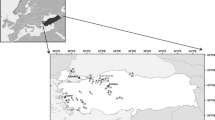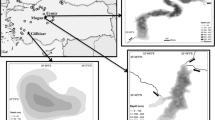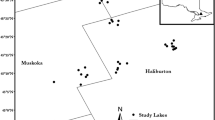Abstract
Shallow lakes have been affected by a variety of human activities profoundly altering their ecological structure and function. Cladocerans have been used to track change resulting from a variety of drivers at a number of time scales. Aquatic macrophytes are well recognised as reflecting the ecological condition of a lake. Here, we compare the plant macrofossils with the sub-fossil cladoceran assemblages from 20 dated sediment cores. Co-correspondence analysis was used to determine the degree of commonality of change in community composition of the two biological groups through time. This analysis revealed very high levels of agreement in the nature and timing of change at all the sites examined with very high correlation coefficients between the axis 1 scores for macrofossils and cladocerans. Furthermore, at all sites a high proportion of the variance (min 20%, max 54%) in the macrofossil data was explained by the change in the cladoceran assemblage. Sub-fossil macrofossil and cladoceran assemblages, from at least from 1700 AD onwards, were examined in more detail at three sites: Ormesby Great Broad, Felbrigg Lake and Lake Søbygaard. There was very good accord in the main shifts of the cladoceran and macrofossil assemblages at all three sites. This may reflect the long-term shift in the principal focus of primary production from the benthic to the pelagic habitat. We suggest that the combination of their central position in the food-web and the presence of both pelagic and benthic taxa make cladocerans a strong candidate as the single best indicator of (palaeo) ecological condition related to changing trophic status and alteration in food-web structure in shallow lakes.




Similar content being viewed by others
References
Alonso, M., 1996. Crustacea, Branchiopoda, Vol. 7. CSIC, Madrid.
Amsinck, S., E. Jeppesen & F. Landkildehus, 2005. Inference of past changes in zooplankton community structure and planktivorous fish abundance from sedimentary subfossils—a study of a coastal lake subjected to major fish kill incidents during the past century. Archiv für Hydrobiologie 162: 363–382.
Appleby, P. & F. Oldfield, 1983. The assessment of 210Pb data from sites with varying sediment accumulation rates. Hydrobiologia 103: 29–35.
Battarbee, R., D. Charles, S. Dixit & I. Renberg, 2010. Diatoms as indicators of surface water acidity. In Smol, J. & E. Stoermer (eds), The Diatoms: Applications for the Environmental and Earth Sciences, 2nd ed. Cambridge University Press, Cambridge: 98–121.
Bayley, S., I. Creed, G. Sass & A. Wong, 2007. Frequent regime shifts in trophic states in shallow lakes on the Boreal Plain: alternative “unstable” states? Limnology and Oceanography 52: 2002–2012.
Birks, H., 2001. Plant macrofossils. In Smol, J., H. Birks & W. Last (eds), Tracking Environmental Change using Lake Sediments—Vol. 3: Terrestrial, Algal, and Siliceous Indicators. Kluwer, Netherlands: 49–74.
Blindow, I., 1992. Decline of charophytes during eutrophication: comparison with angiosperms. Freshwater Biology 28: 9–14.
Brodersen, K. & R. Quinlan, 2006. Midges as palaeoindicators of lake productivity, eutrophication and hypolimnetic oxygen. Quaternary Science Reviews 25: 1995–2012.
Brodersen, K., B. Odgaard, O. Vestergaard & N. Anderson, 2001. Chironomid stratigraphy in the shallow and eutrophic lake Sobygaard, Denmark: chironomid-macrophyte co-occurrence. Freshwater Biology 46: 253–267.
Brooks, J. & S. Dodson, 1965. Predation, body size, and composition of plankton. Science 150: 28–35.
Carpenter, S. & D. Lodge, 1986. Effects of submersed macrophytes on ecosystem processes. Aquatic Botany 26: 341–370.
Carpenter, S., J. Kitchell & J. Hodgson, 1985. Cascading trophic interactions and lake productivity. Bioscience 35: 634–639.
Davidson, T., 2006. Zooplankton ecology and palaeoecology in nutrient enriched shallow lakes. PhD Thesis: 191.
Davidson, T., C. Sayer, H. Bennion, C. David, N. Rose & M. Wade, 2005. A 250 year comparison of historical, macrofossil and pollen records of aquatic plants in a shallow lake. Freshwater Biology 50: 1671–1686.
Davidson, T., C. Sayer, M. Perrow, M. Bramm & E. Jeppesen, 2007. Are the controls of species composition similar for contemporary and sub-fossil cladoceran assemblages? A study of 39 shallow lakes of contrasting trophic status. Journal of Paleolimnology 38: 117–134.
Davidson, T., G. Clarke, D. Morley, N. Rose, C. Sayer & S. Turner, 2008a. Palaeoecological investigation of the past biological structure and function in the Trinity Broads ECRC Research Report, Vol. 122.
Davidson, T., G. Clarke, R. Rawcliffe, J. Salgado, A. Burgess, S. Turner, H. Yang, M. Hughes & B. Goldsmith, 2008b. Palaeoecological assessment of fresh waters in SACs and ASSIs in Northern Ireland ECRC Research Report, Vol. 130.
Davidson, T., C. Sayer, P. Langdon, A. Burgess & M. Jackson, 2010a. Inferring past zooplanktivorous fish and macrophyte density in a shallow lake: application of a new regression tree model. Freshwater Biology 55: 584–599.
Davidson, T., C. Sayer, M. Perrow, M. Bramm & E. Jeppesen, 2010b. The simultaneous inference of zooplanktivorous fish and macrophyte density from sub-fossil cladoceran assemblages: a multivariate regression tree approach. Freshwater Biology 55: 546–564.
Davis, F. W., 1985. Historical changes in submerged macrophyte communities of upper Chesapeake Bay. Ecology 66: 981–993.
Duigan, C., W. Kovach & M. Palmer, 2007. Vegetation communities of British lakes: a revised classification scheme for conservation. Aquatic Conservation: Marine and Freshwater Ecosystems 17: 147–173.
European Union, 2000. Directive 2000/60/EC of the European Parliament and of the Council of 23 October 2000 on establishing a framework for community action in the field of water policy. Official Journal of the European Communities L327: 1–72.
Flössner, D., 1972. Krebstiere. Crustacea. Kiemen- und Blattfusser. Branchiopoda. Fishlause. Brachiura, Vol. 60. Gustav Fisher Verlag, Jena.
Flössner, D., 2000. Die Haplopoda und Cladocera (ohne Bosminidae) Mitteleuropas. Backhuys Publishers, Leiden.
Frey, D., 1958. The late-glacial cladoceran fauna of a small lake. Archiv für Hydrobiolgie 54: 209–275.
Frey, D., 1959. The taxonomic and phylogenetic significance of the head pores of the Chydoridae (Cladocera). Internationale Revue der Gesamten Hydrobiologie 44: 27–50.
Grimm, E. C., 1987. CONISS: a FORTRAN 77 program for stratigraphically constrained cluster analysis by the method of incremental sum of squares* 1. Computers and Geosciences 13: 13–35.
Hall, R. & J. Smol, 2010. Diatoms as indicators of lake eutrophication. In Smol, J. & E. Stoermer (eds), The Diatoms: Applications for the Environmental and Earth Sciences, 2nd ed. Cambridge University Press, Cambridge: 122–151.
Hofmann, W., 1996. Empirical relationships between cladoceran fauna and trophic state in thirteen northern German lakes: analysis of surficial sediments. Hydrobiologia 318: 195–201.
Jeppesen, E., P. Nõges, T. Davidson, J. Haberman, T. Nõges, K. Blank, T. Lauridsen, M. Søndergaard, C. Sayer, R. Laugaste, L. Johansson, R. Bjerring & S. Amsinck, this volume. Zooplankton as indicators in lakes: a scientific based plea for including zooplankton in the ecological quality assessment of lakes according to the European Water Framework Directive (WFD). Hydrobiologia. doi:10.1007/s10750-011-0831-0.
Jeppesen, E., M. Søndergaard, O. Sortkjoær, E. Mortensen & P. Kristensen, 1990. Interactions between phytoplankton, zooplankton and fish in a shallow, hypertrophic lake: a study of phytoplankton collapses in Lake Søbygård, Denmark. Hydrobiologia 191: 149–164.
Jeppesen, E., E. Madsen, J. Jensen & N. Anderson, 1996. Reconstructing the past density of planktivorous fish and trophic structure from sedimentary zooplankton fossils: a surface sediment calibration data set from shallow lakes. Freshwater Biology 36: 115–127.
Jeppesen, E., M. Søndergaard, M. Søndergaard & K. Christoffersen, 1997. The Structuring Role of Submerged Macrophytes in Lakes. Springer, New York.
Jeppesen, E., M. Sondergaard, J. P. Jensen, E. Mortensen, A. Hansen & T. Jorgensen, 1998. Cascading trophic interactions from fish to bacteria and nutrients after reduced sewage loading: an 18-year study of a shallow hypertrophic lake. Ecosystems 1: 250–267.
Jeppesen, E., P. Leavitt, L. De Meester & J. Jensen, 2001. Functional ecology and palaeolimnology: using cladoceran remains to reconstruct anthropogenic impact. Trends in Ecology and Evolution 16: 191–198.
Jeppesen, E., J. Jensen, S. Amsinck, F. Landkildehus, T. Lauridsen & S. Mitchell, 2002. Reconstructing the historical changes in Daphnia mean size and planktivorous fish abundance in lakes from the size of Daphnia ephippia in the sediment. Journal of Paleolimnology 27: 133–143.
Jeppesen, E., J. Jensen, C. Jensen, B. Faafeng, D. Hessen, M. Sondergaard, T. Lauridsen, P. Brettum & K. Christoffersen, 2003a. The impact of nutrient state and lake depth on top-down control in the pelagic zone of lakes: a study of 466 lakes from the temperate zone to the arctic. Ecosystems 6: 313–325.
Jeppesen, E., J. Jensen, T. Lauridsen, S. Amsinck, K. Christoffersen, M. Søndergaard & S. Mitchell, 2003b. Sub-fossils of cladocerans in the surface sediment of 135 lakes as proxies for community structure of zooplankton, fish abundance and lake temperature. Hydrobiologia 491: 321–330.
Johansson, L., S. Amsinck, R. Bjerring & E. Jeppesen, 2005. Mid-to late-Holocene land-use change and lake development at Dallund So, Denmark: trophic structure inferred from cladoceran subfossils. The Holocene 15: 11–43.
Juggins, S., 2003. C2 User Guide. Software for Ecological and Palaeoecological Data Analysis and Visualisation. University of Newcastle, Newcastle upon Tyne.
Kerfoot, W., 1981. Long-term replacement cycles in cladoceran communities: a history of predation. Ecology 62: 216–233.
Kitchell, J. & J. Kitchell, 1980. Size-selective predation, light transmission, and oxygen stratification: evidence from the recent sediments of manipulated lakes. Limnology and Oceanography 25: 389–402.
Korhola, A. & M. Rautio, 2001. Cladocera and other branchiopod crustaceans. In Smol, J., H. Birks & W. Last (eds), Tracking Environmental Change Using Lake Sediments, Volume 4: Zoological Indicators. Kluwer, Dordecht: 5–41.
Leavitt, P., S. Carpenter & J. Kitchell, 1989. Whole-lake experiments: the annual record of fossil pigments and zooplankton. Limnology and Oceanography 34: 700–717.
Liboriussen, L. & E. Jeppesen, 2003. Temporal dynamics in epipelic, pelagic and epiphytic algal production in a clear and a turbid shallow lake. Freshwater Biology 48: 418–431.
Livingstone, D., 1955. A lightweight piston sampler for lake deposits. Ecology 36: 137–139.
Mackereth, F., 1969. A short core sampler for subaqueous deposits. Limnology and Oceanography 14: 145–151.
Manca, M., B. Torretta, P. Comoli, S. Amsinck & E. Jeppesen, 2007. Major changes in trophic dynamics in large, deep sub-alpine Lake Maggiore from 1940s to 2002: a high resolution comparative palaeo-neolimnological study. Freshwater Biology 52: 2256–2269.
McGowan, S., P. Leavitt, R. Hall, N. Anderson, E. Jeppesen & B. Odgaard, 2005. Controls of algal abundance and community composition during ecosystem state change. Ecology 86: 2200–2211.
Moss, B., 1990. Engineering and biological approaches to the restoration from eutrophication of shallow lakes in which aquatic plant communities are important components. Hydrobiologia 200(201): 367–377.
Nykänen, M., K. Vakkilainen, M. Liukkonen & T. Kairesalo, 2009. Cladoceran remains in lake sediments: a comparison between plankton counts and sediment records. Journal of Paleolimnology 42: 551–570.
Nykänen, M., T. Malinen, K. Vakkilainen, M. Liukkonen & T. Kairesalo, 2010. Cladoceran community responses to biomanipulation and re-oligotrophication in Lake Vesijärvi, Finland, as inferred from remains in annually laminated sediment. Freshwater Biology 55: 1164–1181.
Odgaard, B. V., 1993. The sedimentary record of spheroidal carbonaceous fly-ash particles in shallow Danish lakes. Journal of Paleolimnology 8: 171–187.
Oksanen, J., R. Kindt, P. Legendre, B. O’Hara, G. L. Simpson, M. H. H. Stevens & H. Wagner, 2008. Vegan: Community Ecology Package R Package Version 113-2. http://vegan.r-forge.r-project.org/.
Penning, W. E., M. Mjelde, B. Dudley, S. Hellsten, J. Hanganu, A. Kolada, M. Berg, S. Poikane, G. Phillips, N. Willby & F. Ecke, 2008. Classifying aquatic macrophytes as indicators of eutrophication in European lakes. Aquatic Ecology 42: 237–251.
R Core Development Team, 2007. R: A Language and Environment for Statistical Computing. R Foundation for Statistical Computing, Vienna, Austria.
Rasmussen, P. & N. Anderson, 2005. Natural and anthropogenic forcing of aquatic macrophyte development in a shallow Danish lake during the last 7000 years. Journal of Biogeography 32: 1993–2005.
Renberg, I. & M. Wik, 1984. Dating recent lake sediments by soot particle counting. Verhandlungen der Internationalen Vereinigung für Limnologie 2: 712–718.
Rose, N. & P. Appleby, 2005. Regional applications of lake sediment dating by spheroidal carbonaceous particle analysis I: United Kingdom. Journal of Paleolimnology 34: 349–361.
Rose, N., S. Harlock, P. Appleby & R. Battarbee, 1995. The dating of recent lake sediments in the United Kingdom and Ireland using spheroidal carbonaceous particle concentration profiles Holocene 5: 328–335.
Salgado, J., C. Sayer, L. Carvalho, T. Davidson & I. Gunn, 2010. Assessing aquatic macrophyte community change through the integration of palaeolimnological and historical data at Loch Leven, Scotland. Journal of Paleolimnology 43: 191–204.
Sand-Jensen, K., N. Pedersen, I. Thorsgaard, B. Moeslund, J. Borum & K. Brodersen, 2008. 100 years of vegetation decline and recovery in Lake Fure, Denmark. Journal of Ecology 96: 260–271.
Sarmaja-Korjonen, K. & P. Alhonen, 1999. Cladoceran and diatom evidence of lake-level fluctuations from a Finnish lake and the effect of acquatic-moss layers on microfossil assemblages. Journal of Paleolimnology 22: 277–290.
Sarmaja-Korjonen, K. & H. Hyvarinen, 2002. Subfossil littoral Cladocera as indicators of brackish-water Littorina transgression of the Baltic Basin in a small lake in Finland. Boreas 31: 356–361.
Sayer, C. D., A. Burgess, K. Kari, T. A. Davidson, S. Peglar, H. Yang & N. Rose, 2010a. Long-term dynamics of submerged macrophytes and algae in a small and shallow, eutrophic lake: implications for the stability of macrophyte-dominance. Freshwater Biology 55: 565–583.
Sayer, C. D., T. A. Davidson & J. I. Jones, 2010b. Seasonal dynamics of macrophytes and phytoplankton in shallow lakes: a eutrophication-driven pathway from plants to plankton? Freshwater Biology 55: 500–513.
Sayer, C. D., T. A. Davidson, J. I. Jones & P. G. Langdon, 2010c. Combining contemporary ecology and palaeolimnology to understand shallow lake ecosystem change. Freshwater Biology 55: 487–499.
Schaffers, A. P., I. P. Raemakers, K. V. Sýkora & C. J. F. Ter Braak, 2008. Arthropod assemblages are best predicted by plant species composition. Ecology 89: 782–794.
Scheffer, M., S. Hosper, M. Meijer, B. Moss & E. Jeppesen, 1993. Alternative equilibria in shallow lakes. Trends in Ecology and Evolution 8: 275–279.
Schriver, P., J. Bogestrand, E. Jeppesen & M. Sondergaard, 1995. Impact of submerged macrophytes on fish-zooplankton-phytoplankton interactions: large-scale enclosure experiments in a shallow eutrophic lake. Freshwater Biology 33: 255–270.
Simpson, G. L., 2009. cocorresp: Co-Correspondence Analysis Ordination Methods (R Package Version 01-9). http://cran.r-project.org/package=cocorresp.
Smol, J., H. Birks & W. Last, 2001. Tracking Environmental Change Using Lake Sediments: Zoological Indicators, Vol. 4. Kluwer, Dordrecht.
Søndergaard, M., E. Jeppesen, J. P. Jensen & S. L. Amsinck, 2005. Water framework directive: ecological classification of Danish lakes. Journal of Applied Ecology 42: 616–629.
Søndergaard, M., E. Jeppesen, T. L. Lauridsen, C. Skov, E. H. Van Nes, R. Roijackers, E. Lammens & R. Portielje, 2007. Lake restoration: successes, failures and long-term effects. Journal of Applied Ecology 44: 1095–1105.
Søndergaard, M., L. Johansson, T. Lauridsen, T. Jørgensen, L. Liboriussen & E. Jeppesen, 2010. Submerged macrophytes as indicators of the ecological quality of lakes. Freshwater Biology 55: 893–908.
ter Braak, C. & I. Prentice, 1988. A theory of gradient analysis. Advances in Ecological Research 18: 271–317.
ter Braak, C. & A. Schaffers, 2004. Co-correspondence analysis: a new ordination method to relate two community compositions. Ecology 85: 834–846.
Thoms, M., R. Ogden & M. Reid, 1999. Establishing the condition of lowland floodplain rivers: a palaeo-ecological approach. Freshwater Biology 41: 407–423.
Timms, R. & B. Moss, 1984. Prevention of growth of potentially dense phytoplankton populations by zooplankton grazing, in the presence of zooplanktivorous fish, in a shallow wetland ecosystem. Limnology and Oceanography 29: 472–486.
Tomlinson, M., M. Perrow, D. Hoare, J. A. Pitt, S. Johnson, C. Wilson & D. Alborough, 2002. Restoration of Ormesby Broad through biomanipulation: ecological, technical and sociological issues. In Cowx, I. G. (ed.), Management and Ecology of Lake and Reservoir Fisheries. Blackwell, Oxford: 184–202.
Vadeboncoeur, Y., E. Jeppesen, M. Zanden, H. Schierup, K. Christoffersen & D. Lodge, 2003. From Greenland to green lakes: cultural eutrophication and the loss of benthic pathways in lakes. Limnology and Oceanography 48: 1408–1418.
Vanni, M., 1987. Effects of food availability and fish predation on a zooplankton community. Ecological Monographs 57: 61–88.
Whiteside, M., 1970. Danish Chydorid Cladocera: modern ecology and core studies. Ecological Monographs 40: 79–118.
Zhao, Y., C. Sayer, H. Birks, M. Hughes & S. Peglar, 2006. Spatial representation of aquatic vegetation by macrofossils and pollen in a small and shallow lake. Journal of Paleolimnology 35: 335–350.
Acknowledgments
We are grateful to Karina Jensen for cladoceran identification for the Danish sites. We are thankful to many members of the ECRC and NERI for invaluable assistance in the field, in particular ‘big’ Ben Goldsmith, Daniel Hoare, Hannah Gray & James Shilland. We owe thanks to Neil Rose and Handong Yang for sediment core dating of UK and Northern Ireland sites. The various projects that make up this article were supported by The Broads Authority, The Environment and Heritage Service of Northern Ireland, Essex and Suffolk Water and The Countryside Council for Wales. We are grateful to the Catherine Duigan, Tristan Hatton-Ellis and Tony Waterman for their help. The project was supported by the EU-WISER and REFRESH projects, ‘CLEAR’ (a Villum Kann Rasmussen Centre of Excellence Project) and the Research Council for Nature and Universe (272-08-0406). TD’s contribution was supported by the Marie Curie Intra European Fellowship no. 255180 (PRECISE).
Author information
Authors and Affiliations
Corresponding author
Additional information
Guest editors: H. Eggermont & K. Martens / Cladocera as indicators of environmental change
Rights and permissions
About this article
Cite this article
Davidson, T.A., Bennion, H., Jeppesen, E. et al. The role of cladocerans in tracking long-term change in shallow lake trophic status. Hydrobiologia 676, 299–315 (2011). https://doi.org/10.1007/s10750-011-0851-9
Received:
Accepted:
Published:
Issue Date:
DOI: https://doi.org/10.1007/s10750-011-0851-9




